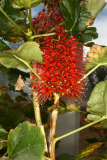Additional notes (click to expand)
Commemorative
This, the Natal Bottlebrush, comes from South Africa and is named after the physician Dr Peter
Cormack Sutherland (1822–1900). He was born in Scotland, and studied medicine and geology.
In 1850 he was the ship’s surgeon, sailing in HMS Sophia, to discover the fate of Sir John Franklin’s ill-fated expedition (1845) with HMS Erebus and HMS Terror, which had been lost in the
Arctic. Frozen into the ice in Assistance Bay to the south of Cornwallis Island in HMS Sophia with her companion ship HMS Lady Franklin and the schooner Felix, they sent out long-distance
sledging parties looking for the lost men. They never found Franklin or the ships, only the graves of some of the crew on King William Island. He wrote an account in Journal of a voyage in Baffin’s Bay and Barrow Straits (2 vols, 1852), which included plants collected. He brought back 88 zoological specimens, 26 plants, 80 minerals and 30 fossils, which were deposited at the Royal Navy Hospital Museum at Haslar. He is described as ‘a most indefatigable offi cer, and his attention while on board to natural history and meteorology will no doubt afford many useful facts’. He also wrote the meteorology and geology section of Sir Edward Inglefield’s A summer search for Sir John Franklin; with a peep into the Polar Basin (1853). Sutherland emigrated to Durban in 1853, where he set up in medical practice, but succeeded to the post of surveyor-general of Natal on the death of William Stanger in 1855. Later, in 1873, he designed a new town, Stanger, which he named after his
predecessor. He named a hill, Garden Castle, after his second wife (Jane Garden Blaikie, married 1863). It was written of him that ‘the span of his life was so long and the range of his interests so wide that his biography is virtually the history of Natal’. He was on the Natal legislative council, the fi rst surgeon to the Military Volunteer Corps and chairman of the Natal Medical Committee (1856–96). He was a man of wide interests, from temperance to agriculture, natural history to education, who ‘played a vigorous part in the intellectual atmosphere of the colonial capital’ (Edington, 1963).
Oakeley, Dr. Henry. (2012). Doctors in the Medicinal Garden. Plants named after physicians. Royal College of Physicians. p.72
link
The genus name, Greyia, is for Sir George Grey (1812–98), a soldier, explorer and colonial
administrator who was variously governor of South Australia, Cape Colony in South Africa and of New Zealand, and latterly was premier of New Zealand. An interesting personage
much involved with wars with the original inhabitants of these countries. He provided the
money for Grey’s Hospital in Pietermaritzburg in 1855, which was built under the supervision
of Dr Sutherland.
Oakeley, Dr. Henry. (2012). Doctors in the Medicinal Garden. Plants named after physicians. Royal College of Physicians. p.74
link
Horticulture
In the family Melianthaceae, Greyia sutherlandii is a frost-tender shrub found on inclines and upland crags up to 1,800 metres in South Africa. In the Medicinal Garden, with a thick layer of bark mulch for protection, it has survived two consecutive severe winters in a sheltered well-drained border. It can be propagated by cuttings from new growth in spring or by removal of rooted suckers. Pruning is not necessary, but it can be lightly trimmed after flowering if required. (Clare Beacham)
Oakeley, Dr. Henry. (2012). Doctors in the Medicinal Garden. Plants named after physicians. Royal College of Physicians.
link
Nomenclature
Natalse baakhout (Afr.); isiDwadwa, inDalu, uBande (Zulu); umBere-bere (Xhosa)
Family name change - Previously Greyiaceae
Plants of the World online, Kew Science
link
Geographical distribution
- Africa, Southern Africa, Cape Provinces
- Africa, Southern Africa, Free State
- Africa, Southern Africa, KwaZulu-Natal
- Africa, Southern Africa, Swaziland
Greyia sutherlandii Hook. & Harv.
Family: FRANCOACEAEGenus: Greyia
Species: sutherlandii Hook. & Harv.
Common names: Natal Bottlebrush
Distribution summary: South Africa
Habit: Shrub
Hardiness: H3 - Half hardy; unheated greenhouse/mild winter
Habitat: Slopes and rocky ridges to 1800m
Garden status: Currently grown
Garden location: Southern Hemisphere Wolfson bed (N), Southern Hemisphere Wolfson bed (N)
Reason for growing: Commemorative


.JPG)
.JPG)
